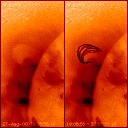Shrinkage of Coronal X-ray loops
Shrinkage of Coronal X-ray loops
Science Nugget: September 29, 2000
Introduction
One of the earliest big discoveries by the Yohkoh mission may
have been the notion that the solar corona above active regions is
continuously expanding
outwards into space. This result was possible, in part, to the high temporal
continuity of the SXT movie. It was brand-new stuff. One can
confirm this effect very simply -- run the Yohkoh movie backwards, and
come away with the impression that the sun is systematically sucking
up the solar corona.
Perhaps this notion of an ever-expanding solar corona is an obvious
one, based solely on thermodynamic (or perhaps statistical)
considerations alone: there is always a tendency towards increased
entropy. There's always a tendency to fill a vacuum, water will
always find a way into a dry pair of shoes, and college dorm rooms
will always be trashed by the end of the semester.
Always on the lookout for something new, this nugget considers the
opposing view: shrinking coronal loops.
How so?
The idea of shrinking loops is not a new one. The concept has been
explored by numerous authors, including
J. Wang,
Z. Svestka,
and
Forbes and Acton.
Furthermore, this topic has been explored to some degree by our own
Hugh Hudson in the literature and
also here
in our own database o'
Science nuggets.
It's easy to imagine a
scenario where active region loops will want to expand: they tend to
be light, hot, and the magnetic field has a tendency to push away from
all the other magnetic field (in a great effort to fill all available
space).
There's a ready source of new magnetic pressure from "emerging flux",
whose name describes the phenomenon.
But how is it possible for a loop structure to shrink? Some ideas
include...
-
Magnetic Implosion during solar flares,
- A change in coronal currents, giving rise to increased magnetic
tension,
- Opposing magnetic footpoints moving towards one another, increasing
the magnetic tension in the "tie-down field"),
- A change in the aspect of the loop as the sun rotates it over
the limb,
- An increase in magnetic pressure in overlying loops, or perhaps...
- None Of The Above.
Show me the data.
We return to the ApJ paper of J. Wang because he's got some wonderful
figures available over the web. One of the many striking plates from
his paper:
 The loops to the South (left) can be seen to be contracting towards the
active region, while the loops to the East (top) are slowly expanding
outwards. Wang felt this was a real contracting event as the loop
height decreased smoothly while the footpoint separation remained
relatively constant.
The loops to the South (left) can be seen to be contracting towards the
active region, while the loops to the East (top) are slowly expanding
outwards. Wang felt this was a real contracting event as the loop
height decreased smoothly while the footpoint separation remained
relatively constant.
I'm still not buying it.
In SXT data, we've found Yet Another Event supporting the notion of
contracting loops, carefully annotated in the following figure:
 The outline of the loop structure is shown, in time, by the curves
illustrated on the above plot. This is perhaps better demonstrated in
the following movie:
The outline of the loop structure is shown, in time, by the curves
illustrated on the above plot. This is perhaps better demonstrated in
the following movie:

The entire movie takes place over a 5-hour period. One explanation
might be that solar rotation changes the aspect of this loop structure,
but the footpoints (to the right of the solar limb) move far less
quickly than do the looptop structures, which suggests to us that the
aspect isn't changing that much. As we mentioned earlier,
there are several possibible explanations for this shrinkage. We think
that perhaps it has something to do with a change in
the magnetic configuration of this active region, somewhere just over
the limb (or behind the bright core of this region) where we can't
really tell what's going on.
September 29, 2000
Brian Handy
<handy@isass0.solar.isas.ac.jp>



